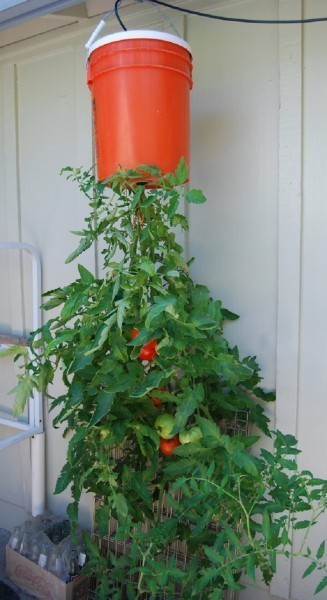






Upside-down gardening is easy. All you need to get started are some large hanging containers, potting soil (amended with compost), and plants. Of course, with any type of gardening, it doesn’t hurt to have a plan beforehand. For instance, know what you want to plant, how much you want to plant, and where you want to hang it.
For larger plants and crops, such as your tomatoes and cucumbers, for example, most people prefer using an ordinary 5-gallon bucket. Buckets are not only easy to come by, as most of us more than likely have one or two already on hand, but they are also sturdy and great for hanging. Alternatively, you can use large, plastic hanging baskets as well as smaller versions for smaller plants.
Once you have chosen suitable containers, you’ll have to drill a hole into the bottom. Typically, the hole needs to be about 2 inches for large containers and buckets and slightly smaller for others, depending on their size. It often helps to have a place to hang these containers while preparing your upside-down garden, as you’ll need to flip the container back over (right side up) for plant placement.
Before placing your plant into the container, locate something to place into its bottom, such as a small piece of newspaper, landscaping fabric or a coffee filter. This will be used for anchoring the plant in place until it’s strong enough to hold its own. It will also prevent the soil from washing out through the hole during watering. Place a slit in the material for the seedling (or small plant) to maneuver through and then carefully guide the plant down into and through the hole, upside down.
As you hold the plant’s root ball in place, begin filling in around it with the soil/compost mix, taking care to tamp the soil as you go. Continue filling the container with soil just until you reach about an inch or so from its rim.
For additional interest and space, add some low-growing plants in the top portion of the container. This can range from small crops, like lettuce, to a handful of herbs, like basil and parsley. You could also choose to place an attractive flowering plant, such as petunia, into the top as well.
Hang your upside-down garden in a sunny location and water it thoroughly, making sure it reaches the bottom. In fact, the water should run out of the bottom hole. Watering requirements for your upside-down garden will usually vary according to the types of plants used and your particular climate. Typically, in most places, especially during periods of hot, dry weather, your upside-garden will require watering daily, if not every other day.
Also, make sure that whatever you grow in the bottom of your container shares the same (or similar) growing requirements as those in the top. In other words, don’t put something requiring lots of water with something that requires little. Likewise, don’t put something that enjoys sun with something that prefers shade.
As your plants grow, you may notice them reaching upward toward the sunlight. This is completely normal and will eventually cease as the plants get larger or begin bearing fruit. While it may seem a bit outside the norm, upside-down gardening is a great way to enjoy beautiful flowers and tasty vegetables all at the same time.
What’s more is the fact that it doesn’t take up a whole lot of space, making this the perfect alternative for urban gardeners and others having little ground space. Upside-down gardening also provides the additional benefit of having your plants at eye level, eliminating the need for bending or stooping whether you’re watering or harvesting.
Upside-down gardening, its concept is nothing new, but it might be new to some and exactly what the garden doctor ordered.
Copyright © www.100flowers.win Botanic Garden All Rights Reserved